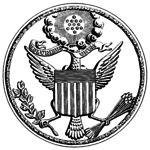President of the Continental Congress
[3] The Continental Congress, fearful of concentrating political power in an individual, gave their presiding officer even less responsibility than the speakers in the lower houses of the colonial assemblies.[4] Unlike some colonial speakers, the president of Congress could not, for example, set the legislative agenda or make committee appointments.[11] Even so, the fact that President Thomas McKean was at the same time serving as Chief Justice of Pennsylvania, provoked some criticism that he had become too powerful.[18] President John Hanson wanted to resign after only a week in office, but Congress lacked a quorum to select a successor, and so he stayed on.[7] President Thomas Mifflin found it difficult to convince the states to send enough delegates to Congress to ratify the 1783 Treaty of Paris.[19] For six weeks in 1784, President Richard Henry Lee did not come to Congress, but instead instructed secretary Charles Thomson to forward any papers that needed his signature.[21] There were not enough delegates present to choose St. Clair's successor until January 22, 1788, when the final president of Congress, Cyrus Griffin, was elected.He left in October 1777 for what he believed was an extended leave of absence, only to find upon his return that Congress had elected Henry Laurens to replace him.It was a small oval, with the crest from the Great Seal (the radiant constellation of thirteen stars surrounded by clouds) in the center, with the motto E Pluribus Unum above it.
Continental CongressMr. PresidentThe HonorablePeyton RandolphCyrus GriffinUnited StatesContinental CongressIndependence HallPhiladelphiaAlbany CongressStamp Act CongressFirst Continental CongressDeclaration and ResolvesContinental AssociationPetition to the KingSecond Continental CongressUnited ColoniesOlive Branch PetitionCommittee of Secret CorrespondenceNecessity of Taking Up ArmsLee ResolutionDeclaration of IndependenceModel TreatyFranco-American TreatyArticles of ConfederationPerpetual UnionCourt of Appeals in Cases of CaptureCongress of the ConfederationBank of North AmericaLand Ordinance of 1784of 1785Northwest Ordinance of 1787List of delegatesSecretary of Foreign AffairsSuperintendent of FinanceBoard of WarSecretary of the Continental CongressJournals of the Continental CongressCarpenters' HallHenry Fite HouseNassau HallMaryland State HouseFrench Arms TavernFederal HalltransitionalUnited StatesAmerican Revolutionpresidentdiscussion moderatorPresident of the United StatesratificationArticles of Confederation and Perpetual Unionoriginal 13 statesVirginiaMassachusettsPennsylvaniaSouth CarolinaConnecticutDelawareMarylandNew JerseyNew Yorkspeakerscolonial assembliesCommittee of the WholeThomas McKeanRichard B. MorrisRevolutionary WarquorumJohn HansonThomas MifflinTreaty of ParisRichard Henry LeeCharles ThomsonJohn HancockDavid RamsayNathaniel GorhamchairmanArthur St. ClairNorthwest OrdinanceUnited States Constitutioncaretaker governmentHenry MiddletonHouse of Burgessesleave of absenceHenry Laurenswent into effectSamuel Huntingtonterm limitSpeakerMassachusetts Provincial CongressJohn JayNew York Supreme CourtMaryland House of DelegatesElias BoudinotContinental ArmyArthur St. ClairVirginia Court of AppealsexecutiveGeorge WashingtonStatuary HallUS Capitolvice president'sUnited States SenateGreat Seal of the United StatesE Pluribus UnumBenson LossingConfederation periodHistory of the United States (1776–1789)Founding Fathers of the United StatesAmerican National Biography OnlineFord, Worthington C.Totten, C.A.L.Lossing, Benson J.Harper's New Monthly MagazineConfederation CongressCongressesDelegatesCommittee of the StatesSecretaryPostmaster GeneralAgent of the MarineSecretary at WarCourt of AppealsCommander in ChiefContinental NavyContinental Marines